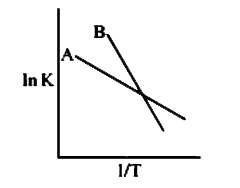For two firstorder reactions having same concentration of and at , use the given data to calculate the tempretature at which both occur with same rate.
Reaction I: ,
Reaction II: ,
Since when Thus,
or
or
Topper's Solved these Questions
- CHEMICAL KINETICSBOOK - CENGAGE CHEMISTRYCHAPTER - CHEMICAL KINETICSEXERCISE - Ex 4.1 (Objective)
9 Videos
- CHEMICAL KINETICSBOOK - CENGAGE CHEMISTRYCHAPTER - CHEMICAL KINETICSEXERCISE - Ex 4.2 (Objective)
10 Videos
- CHEMICAL KINETICSBOOK - CENGAGE CHEMISTRYCHAPTER - CHEMICAL KINETICSEXERCISE - Archives Subjective
23 Videos
- CARBOXYLIC ACIDS AND THEIR DERIVATIVESBOOK - CENGAGE CHEMISTRYCHAPTER - CARBOXYLIC ACIDS AND THEIR DERIVATIVESEXERCISE - Exercises Archives (Analytical And Descriptive)
34 Videos
- COORDINATION COMPOUNDSBOOK - CENGAGE CHEMISTRYCHAPTER - COORDINATION COMPOUNDSEXERCISE - Archives Subjective
18 Videos
Similar Questions
Knowledge Check
A→B,kA=1015e−2000/T
C→D,kc=1014e−1000/T
Temperature at which kA=kc isA1000 KB2000 KC(2000/2.303)KD(1000/2.303)KFor zero order reaction , t1/2 will be (A0 is the initial concentration , K is rate constant)
A0.693/KB2.303/KCA02KDInA02For a gaseous reaction, following data is given:
A→B,k1=1015e−2000/T
C→D,k2=1014e−1000/T
The temperature at which k1=k2 isA1000KB2000KC868.82KD434.2K
For a gaseous reaction , following date is given :
A→B,k1=1015e−2000/T
C→D,K2=1014e−1000/T
The temperature at which k1=k2 is
View Solution(A→B,kA=1015e−2000/T,),(C→D,kC=1014e−1000/T)
Temperature T K at which (kA=kC) is :
View SolutionThe rate constant for a second order reaction is given by k=(5×1011)e−29000k/T. The value of Ea will be:
View SolutionThe rate of reaction increases isgnificantly with increase in temperature. Generally, rate of reactions are doubled for every 10∘C rise in temperature. Temperature coefficient gives us an idea about the change in the rate of a reaction for every 10∘C change in temperature.
Temperature coefficient(μ)=Rate constant of(T+10)∘CRate constant atT∘C
Arrhenius gave an equation which describes aret constant k as a function of temperature
k=Ae−Ea/RT
where k is the rate constant, A is the frequency factor or pre-exponential factor, Ea is the activation energy, T is the temperature in kelvin, R is the universal gas constant.
Equation when expressed in logarithmic form becomes
logk=logA−Ea2.303RT
For the given reactions, following data is given
P→Qk1=1015exp(−2000T)C→Dk2=1014exp(−1000T)
Temperature at which k1=k2 is
View SolutionWhich equation is true to calculate the energy of ativation, if the rate of reaction is doubled by increasing temperature from T1KtoT2K?
View Solution

